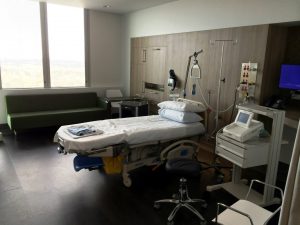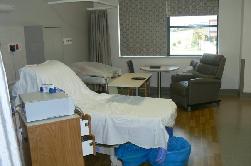Labour and Delivery
Labour
Labour is defined as regular coordinated contractions that cause your cervix to dilate.
When to Contact the Hospital
When you have contractions which become stronger and more regular – every 10 minutes, then you should phone Norwest Hospital Birth Unit (Tel: 02 888 28591) or the San Hospital Birthing Unit (Tel: 02 947 9561). Contractions initially are often felt as low abdominal cramps similar to period pains, perhaps with a backache.
Some women (about 10%) experience rupture of their membranes before the onset of labour. This can occur quite dramatically or as a small leak. If you suspect your membranes have ruptured you should phone Norwest Birth Unit or the San Labour Ward.
Labour is usually heralded by mucous streaked with blood from the vagina which is called a “show”. If this happens you should phone the San Labour Ward or Norwest Birth Unit.
If you have bleeding more than usual then please phone Norwest Birth Unit or the San Labour Ward immediately.
Your Care in Labour
You can do a virtual tour of Norwest and the San Hospital including the Birth Unit /Labour Ward in the photo gallery of our Facebook site.
When you arrive in labour a midwife on duty will be assigned to you to support you and your baby while you are in labour.
This midwife will advise me of your admission. your progress in labour, the well-being of you and your baby and of any significant developments as appropriate. There is no need for you to contact me directly when you go into labour.

Birthing Positions
I plan to keep your delivery as natural as possible.
If all is progressing well you can adopt whatever labour and birthing positions you find more preferable. I do not have strict views about the birthing position. You will find some positions are more effective for pushing in the second stage than others.
As well the use of drapes will be kept to a minimum.
Your baby will be delivered on to your abdomen when possible with consideration of your birthing position. Also, this may not be possible if there is concern about your baby’s well-being at birth or there is an unusually short umbilical cord.
Pain Relief in Labour
You choose.
All popular modern methods of pain relief are available in labour. These include the gas (Nitrous Oxide and Oxygen mix), Pethidine injection and an epidural block. A booklet on epidurals is available.
You should wait until you are in labour before deciding your preference. You do not know how you will cope with the pain of labour or how your labour will progress. Keep an open mind.

See also Am I more likely to have a Caesarean section if I have an epidural for my labour? in the blog section.
Fetal Monitoring in Labour
There will be an initial electronic fetal heart tracing at the onset of labour to assess your baby’s well-being. This is a routine hospital procedure.
This monitoring can be discontinued and there will be intermittent monitoring of the fetal heart in labour as long as there is normal progress in an uncomplicated labour.
If you have a high risk pregnancy, if there are concerns about your baby’s well-being, if you have had a previous Caesarean section, if you have an epidural for pain relief in labour or if there other significant complications then there will be indications for continuous electronic fetal heart rate monitoring. Even if continuous fetal monitoring is necessary, where possible we encourage you to be ambulatory and as active as possible in your labour.
Induction of Labour
Sometimes there are very good reasons why your labour should be induced. These can include concerns about the risks of you going significantly overdue, concerns about your baby’s or your well-being, concerns about your baby’s size being to big for your birth canal, etc.
Some inductions are done for social – your request. This can be requested because of your husband/partner’s travel, your parents arriving from overseas, religious reasons, you are ‘fed up’ and uncomfortable with being pregnant. I will arrange for you to have a social induction if you request as long as you are more than 37 weeks pregnant and the risk of a “failed induction” is minimal. Your suitability to be induced is assessed by a pelvic digital examination. If the pelvic examination findings are such that you are not ready then an attempt at induction is likely to fail and will result in a Caesarean section after hours of trying to get you into labour.
Induction can be with:
- ARM (artificial rupture of membranes) only – if your cervix is very favourable.
- ARM and Syntocinon hormone drip – if your cervix is favourable.
- Prostin gel ripening followed by an ARM and Syntocinon drip – if you cervix is inducible but not favourable for induction. Sometimes you may labour on the Prostin gel and so nothing more is needed.
A common myth is that if you are induced your labour will be more painful. There is no credible evidence to support this view. Another challenge that undermines this assertion is there is so much variation in “natural” labour. Also, it is sometimes said you onset of labour will be quicker if you are induced. Again this is not so unless you are mismanaged or have an unexpected response to the induction process. What induction does need is careful assessment of the cervix, etc to decide the best option and careful management. This is the case for my patients. If the assessment and induction are done by staff who are training or inexperienced or in the public sector then there is likely to be more problems.
See also Induction of Labour in the Questions and Answer section
Syntocinon Augmentation of Labour
This is sometimes necessary because your contactions are suboptimal in strength or frequency or both for you to progress in labour. The midwife assigned to you can determine whether you labour is progressing well by internal examinations. If there is lack of progress then she will advise me and we will discuss options which include augmentation. This lack of progress in labour can be a consequence of it being a ‘tight fit’ and the Syntocinon drip can overcome this and increase your chances of having a normal vaginal delivery.
In about 10% of cases there is spontaneous rupture of membranes (SROM) before you are in labour. If labour does not start after a reasonable time and if you are at least 36 weeks pregnant when this happens then a Syntocinon drip is indicated to start labour. It is safer for your baby than leaving you for a long time with the risk of ascending infection and umbilical cord prolapse.
See also Rupture of Membranes in the Questions and Answer section.
Delivery
My goal is for you to have a spontaneous normal vaginal delivery.
I will work with you in labour to optimise your chances of achieving this. Sometimes is happens easily and sometimes to achieve this requires very careful management that I can provide you because of my considerable experience and expertise as an obstetrician and having managed the labour and delivery of many thousands of women before you.
Your Perineum
I prefer you to have an intact perineum. Failing that my preference is a small tear.
With me as your obstetrician, it is unlikely that you will need an episiotomy if you have a normal delivery or a vacuum delivery. An episiotomy may be required occasionally to avoid a very large tear. If you need a forceps delivery you will need an episiotomy to avoid a large tear.
See also Perineal Tearing at Delivery in the Questions and Answer section.
Operative Vaginal Delivery
This may be necessary because of developments in second stage such as lack of progress in spite of maternal effort or if there is fetal distress.
I am highly skilled in both the use of the vacuum suction cap and forceps. Many obstetricians do not have this range of skills.
See also Vacuum and Forceps in the Questions and Answer section.
Your husband/partner
Your husband/partner is encouraged to stay with you during labour and during the delivery (including operative vaginal delivery and Caesarean section with regional anaesthetic). He is usually your best support person.
He is encouraged to participate in the delivery of his baby unless there is a contraindication, e.g. an urgent vaginal delivery for foetal distress or a Caesarean section. At the very least this will be by him to cut the umbilical cord. I will also invite him to deliver your baby’s body, as long as all is progressing well.

Photos
Make sure your husband/partner brings the camera and that the battery is fully charged! He will also be the photographer on the day, though the midwife is usually keen to help. I allow videos to be taken also.
Other Support People in Labour
This should not be a problem as long as there are not too many! Your request should be discussed with me and the Labour Ward / Birth Unit staff prior to the day you are admitted for your delivery.
Communication
This is your big day! It is the birth of your baby! We want it to be as pleasant an experience as possible.
Good communication is an essential part of this. I will explain as well as I can and in non-technical terms everything that is happening and your labour management options. The midwife will endeavour to do the same.
If you don’t understand something that is happening or are concerned about something that is happening then please let us know so the matter can be discussed and worked through.
Birth Plan
A formal bith plan is not necessary.
The birth plan concept is far more relevant for pregnant women going through the public system to have their baby where there is no personalised care and where their the staff looking after them in the labour are strangers, who often have their own bias as to how you should be managed, irrespective of your thoughts.
I focus on personalised individual pregnancy care and during the course of the pregnancy. I suggest you ask me questions, advise me of expectations and plans at your antenatal visits with me so we can work through them.
I can make relevant notes. That means when you are admitted in labour we are both ‘on the same page’ with consideration of you expectations and wishes. It is very easy for me to bring the midwifery staff ‘up to pace’ with what we have discussed.
See also Birth plan – Do I need one? in the Questions and Answer section.
What is most important?
I believe that mother and baby well-being are the most important considerations and should not be compromised.
I want you to have a successful outcome for yourself and your baby with the minimum intervention necessary and for you and your husband/partner to have a memorable and joyful experience. After all childbirth is one of the most important and exciting times of your life!
See also Labour and Delivery in the Questions and Answer section.
See also Checklist for when baby is almost duein the Blog section.
RECENT ‘LABOUR AND DELIVERY’ ARTICLES:
The challenges of a having large unborn baby
Jennifer (not real name) booked with me for management of her first pregnancy. She and her husband are a delightful couple, and they were very...
Foetal distress in first stage labour, Caesarean section avoided
Emily was in labour for her first baby. Her pregnancy had been uneventful. At 5cm cervical dilatation the midwife who was looking after Emily...
Vacuum cup and forceps
When are vacuum cups and forceps used when delivering a baby? For an operative vaginal delivery and sometimes with a Caesarean section delivery....
Book an appointment now
- Monday all day 9.00am to 4.30pm
- Tuesday all day 9.00am to 4.30pm
- Wednesday all day 9.00am to 4.30pm
- Thursday morning 9.00am to 12.30pm
- Thursday alternate afternoons 2.00pm to 4.30pm
- Friday alternate mornings 9.00am to 1.00pm
- Friday afternoon 2.00pm to 4.30pm
- Saturday mornings 9.30am to 12.00 midday*
*Saturday morning appointments are not available for initial antenatal visit.




